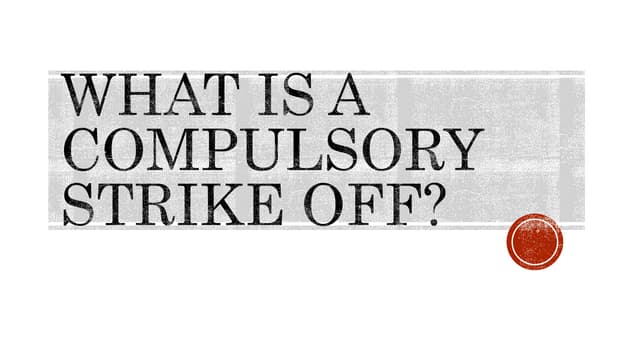A Comprehensive Overview to the Compulsory Strike Off Treatment in Corporate Administration
The compulsory strike off treatment, a vital component in business administration, serves as a system to apply conformity and preserve the integrity of the company environment. As organizations evolve and scenarios modification, the need to strike off a firm may develop for different factors.

Reasons for Compulsory Strike Off
There are a number of key reasons that may trigger the initiation of a mandatory strike off procedure for a company. Non-compliance with regulative requirements can increase worries concerning the company's procedures and monetary health, leading to the choice to strike off the business from the register.
In addition, business that have discontinued trading or are no longer bring out any kind of service activities may additionally deal with required strike off. This might be because of insolvency, mergers, or simply a choice to end up the firm. In such situations, preserving the firm on the register would offer no objective and could potentially create complication amongst stakeholders.
Eventually, the requirement of an obligatory strike off in business administration emerges when a firm is no more operating according to the legislation or has actually come to be inoperative, demanding its removal from the official records.
Lawful Implications and Risks
Given the situations that trigger a required strike off in business governance, it is crucial to understand the legal ramifications and dangers associated with such actions. When a firm is struck off the main register, it stops to exist as a legal entity.
In addition, there are lawful consequences for people associated with the administration of a business that has actually been by force struck off. They might be invalidated from working as directors in the future, face fines, or also jail time if transgression or deceitful tasks are uncovered. In addition, the reputational damages from a mandatory strike off can have enduring results on people and their ability to take part in future service ventures. Recognizing these legal implications and threats is essential for all stakeholders entailed in the business governance procedure to browse possible pitfalls and ensure compliance with the legislation.
Steps in the Strike Off Refine
Initiating the obligatory strike off procedure in company administration entails a series of prescribed actions described by governing authorities. The primary step usually needs the company to submit an official application or notice to the appropriate government firm or registrar signaling its intent to be struck off the official register. Subsequently, the firm is often needed to resolve any type of impressive responsibilities, debts, or tax obligations to guarantee conformity with governing demands.
As soon as the first documentation is sent and financial commitments are satisfied, the regulatory body will release a notice in the official gazette or a similar magazine to notify stakeholders regarding the impending strike off - first gazette additional reading notice for compulsory strike-off. This notice functions as a last opportunity for any interested parties to elevate arguments or present valid factors why the business should not be dissolved
Complying with the magazine of the notice, the governing authority will proceed with the strike off process if no significant arguments or barriers develop. The business will then be formally liquified, and its name will certainly be eliminated from the register, effectively noting the final thought of the obligatory strike off treatment in business governance.
Files Required for Strike Off
In compliance with regulatory standards, specific paperwork needs to be supplied to facilitate the strike off process in company governance. The required records click for more usually consist of a formal application for strike off, which requires to be completed precisely and submitted to the pertinent regulative authority. Furthermore, financial declarations, such as the business's newest annual report, should be included to ensure that all financial obligations have been cleared up prior to launching the strike off procedure. A declaration of solvency or a declaration verifying that the firm has no outstanding liabilities is commonly mandated to demonstrate that the entity can be dissolved without triggering injury to its creditors. Moreover, any kind of required authorizations from investors or board members must be recorded and confined with the application. It is vital to make sure that all the requisite paperwork is carefully ready and sent in accordance with the recommended standards to accelerate the strike off procedure effectively. Failure to offer the needed paperwork may lead to delays or problems in the dissolution of the business.
Post-Strike Off Factors To Consider and obligations
Adhering to the completion of the needed documentation for strike off, interest changes to the post-strike off responsibilities and factors to consider that are necessary in the corporate administration procedure. Once a firm has been struck off the register, it is critical to make sure that all remaining possessions are dealt with properly.

Conclusion
In final thought, the mandatory strike off treatment in business administration functions as a necessary mechanism to eliminate inoperative firms from the register. Comprehending the reasons, lawful effects, actions, and papers required special info for strike off is critical for compliance with regulatory demands. It is vital for firms to meet their post-strike off obligations and think about the implications of this procedure in order to preserve excellent standing and avoid potential risks.
There are a number of crucial factors that might motivate the initiation of a compulsory strike off treatment for a firm (first gazette notice). Non-compliance with governing demands can elevate worries about the firm's operations and financial wellness, leading to the decision to strike off the firm from the register

Comments on “Understanding Compulsory Strike Off: What You Required to Know”